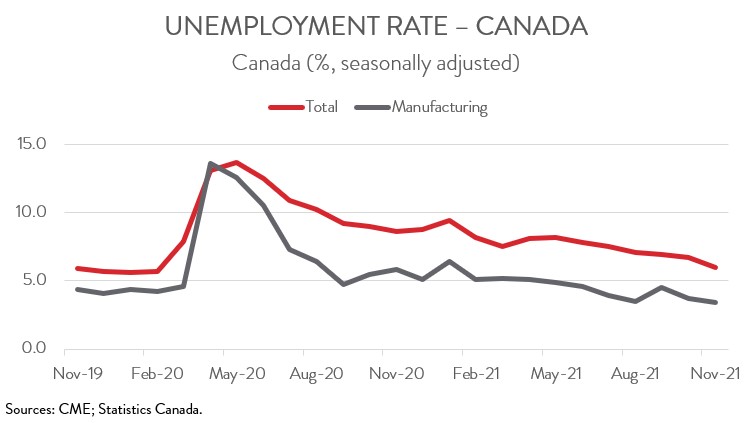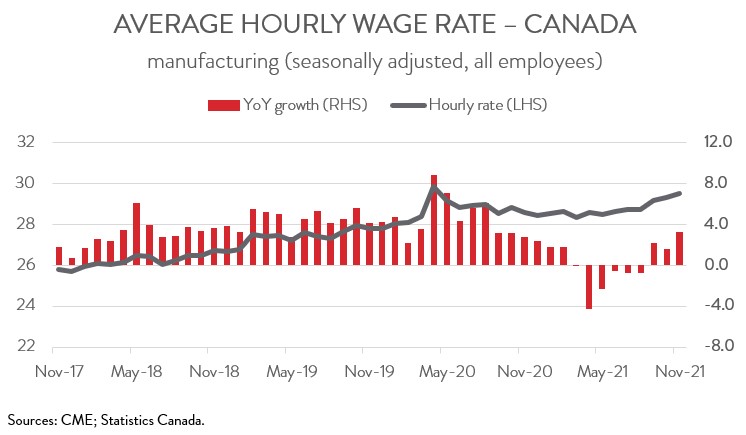Labour Market Trends
Labour Market Trends
NOVEMBER 2021
Employment Increases for Sixth Straight Month in November; Manufacturing Workforce Rises Above Pre-Pandemic Level
HIGHLIGHTS
- Employment rose by 153,700 (+0.8%) in November, the sixth consecutive monthly increase.
- Manufacturers added 34,900 workers to payrolls last month, the biggest gain in 14 months.
- The headline unemployment rate decreased from 6.7% in October to 6.0% in November, while the unemployment rate in manufacturing fell from 3.7% to 3.4%.
- Manufacturing wage growth accelerated to 3.3% year-over-year in November, the fastest pace since August 2020.
- Employment rose in all provinces, led by Ontario, Quebec, Alberta, and Newfoundland and Labrador.
- Quebec and BC posted the largest increases in manufacturing employment.
- Canada’s labour market continued to strengthen in November and moved closer to a full recovery. With inflation running near 5%, pressure is mounting on the Bank of Canada to speed up the start of its interest rate hiking cycle. That said, the economic outlook remains highly uncertain, especially with the Omicron variant circulating.
ECONOMY ADDS 153,700 JOBS IN NOVEMBER
Employment rose by 153,700 (+0.8%) in November, the sixth consecutive monthly increase. This pushed employment to 1.0% above its pre-COVID level. Employment increased in both the services-producing and goods-producing industries and was evenly distributed between full-time and part-time work.

Canada’s labour market continued to strengthen in November and moved closer to a full recovery. With inflation running near 5%, pressure is mounting on the Bank of Canada to speed up the start of its interest rate hiking cycle. That said, the economic outlook remains highly uncertain, especially with the Omicron variant circulating.
MANUFACTURING SECTOR ADDS JOBS AT THE FASTEST PACE IN 14 MONTHS
Manufacturers added 34,900 workers to payrolls in November, the biggest gain since September 2020. Only the health care and social assistance sector (+43,800) created more jobs last month. As a result, manufacturing employment rose above its pre-pandemic level for the first time since April 2021. On the negative side, last month’s gains were mostly concentrated in part-time work (+25,000).
UNEMPLOYMENT RATE APPROACHES PRE-PANDEMIC LEVEL
The headline unemployment rate fell 0.7 percentage points to 6.0% in November—the sixth consecutive monthly drop and the largest decline since March 2021. Prior to the pandemic, the unemployment rate had hit a record low of 5.4% in May 2019 and was 5.7% in February 2020. At the same time, the unemployment rate in manufacturing fell from 3.7% to 3.4%, the lowest level since March 2019.

MANUFACTURING WAGE GROWTH ACCELERATES IN NOVEMBER
With the manufacturing labour market continuing to tighten, it was inevitable that wage growth would eventually pick up. Indeed, the average hourly wage rate in manufacturing increased from $29.31 in October to $29.50 in November, up 0.6% month-over-month and 3.3% year-over-year—the fastest annual pace since August 2020.

EMPLOYMENT CLIMBS IN ALL PROVINCES IN NOVEMBER
The job gains in November were widespread, spanning all ten provinces. Employment in Ontario rose by 68,100, up for the sixth straight month and bringing total gains since May to 421,000. Last month’s increase was all in full-time work.
Following an increase in September and little change in October, employment in Quebec rose by 45,500 (+1.1%) in November. The province’s unemployment rate fell 1.1 percentage points to 4.5%, matching the pre-pandemic rate of February 2020.
Noteworthy job gains were also recorded in Alberta (+15,400), Newfoundland and Labrador (+9,100), Nova Scotia (+3,700), PEI (+2,900), and BC (+4,600). It should be noted, however, that the impact of the BC floods was not captured in this report, given that most of the survey data was already collected before the disaster occurred.
In the manufacturing sector, employment was up in 8 of 10 provinces in November. Quebec led the way with job gains of 17,800, more than offsetting the 15,900 losses in October. At the same time, BC manufacturers added 8,900 workers to payrolls, the fourth consecutive monthly gain. Meanwhile, manufacturing employment in Ontario climbed by 5,100, building on the 6,200 gains in October. As well, manufacturing payrolls increased in all four Atlantic provinces, led by Newfoundland and Labrador (+2,600). On a negative note, manufacturing employment fell for the fourth month in a row in Alberta (-2,000) and for the sixth time in seven months in Manitoba (-700).
